Functional Sentence Perspective There are three dominant conceptions
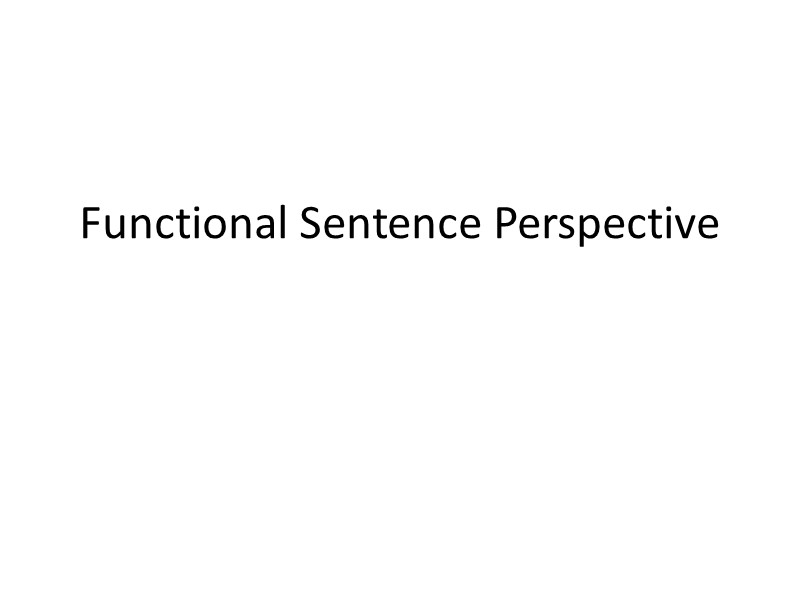
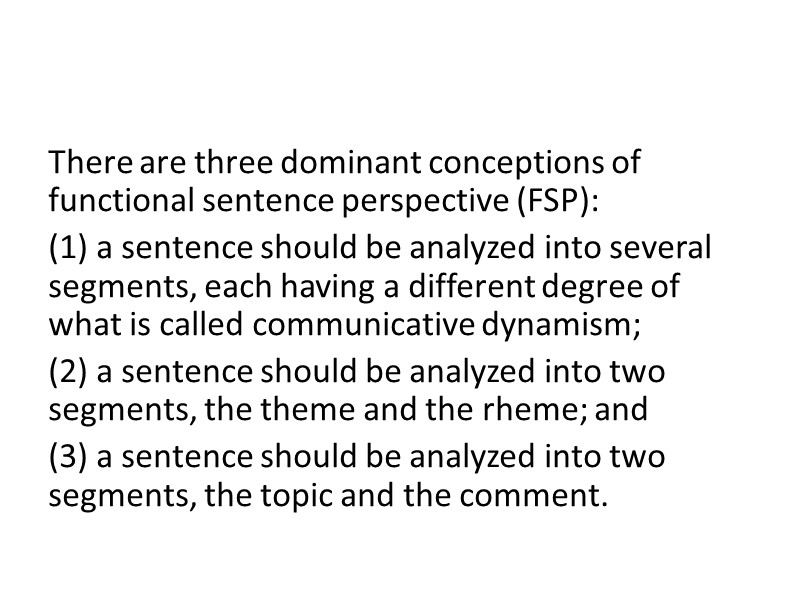
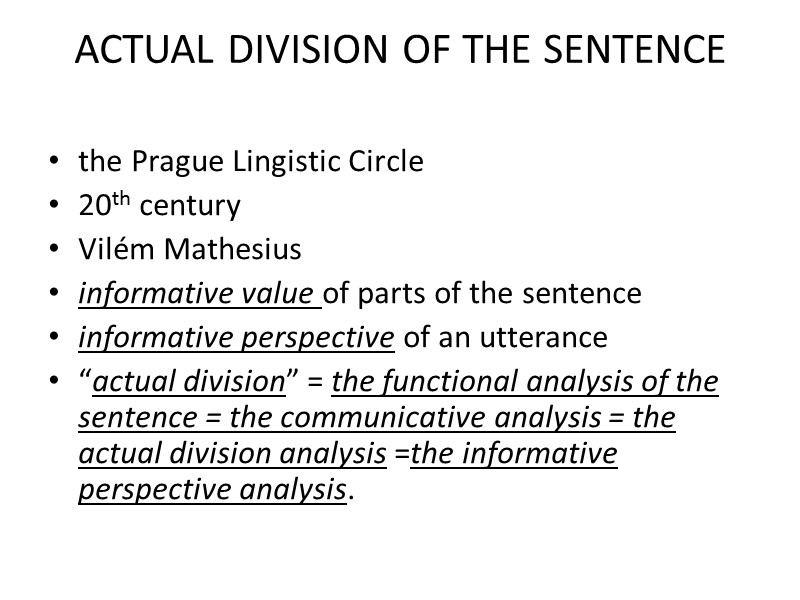
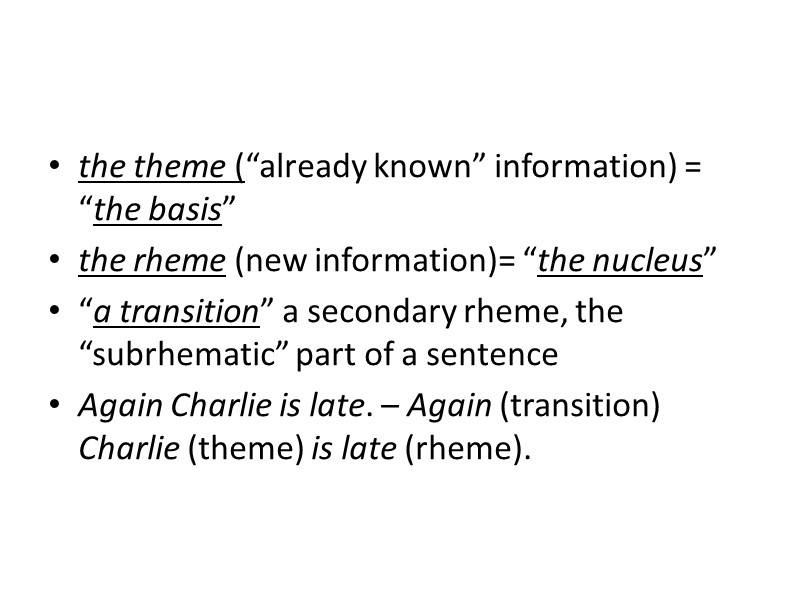
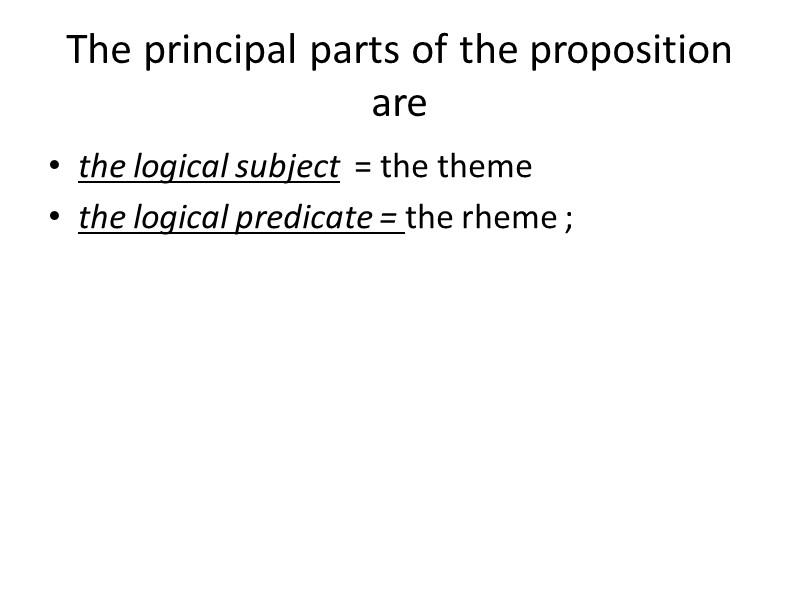
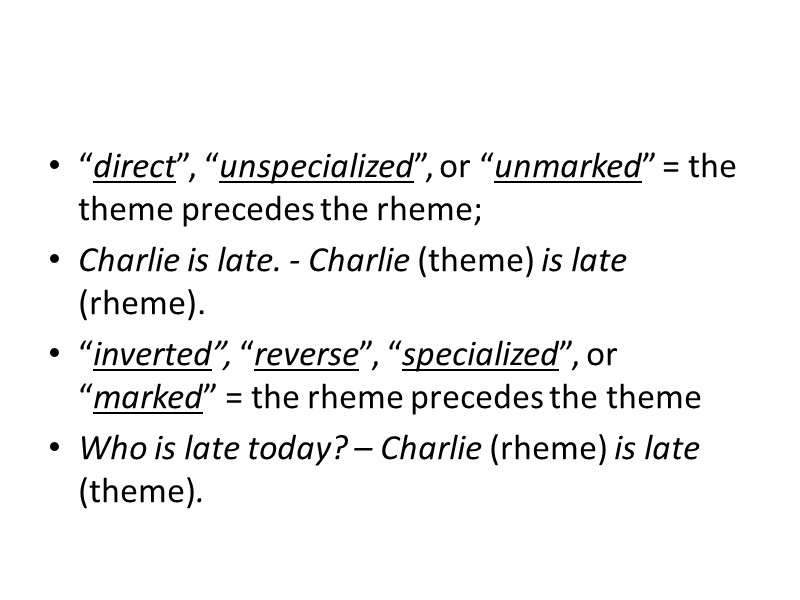
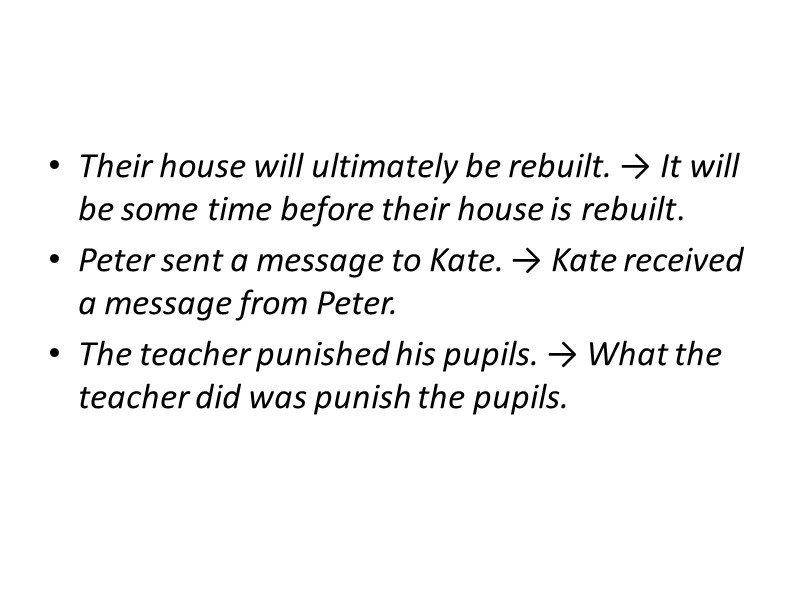
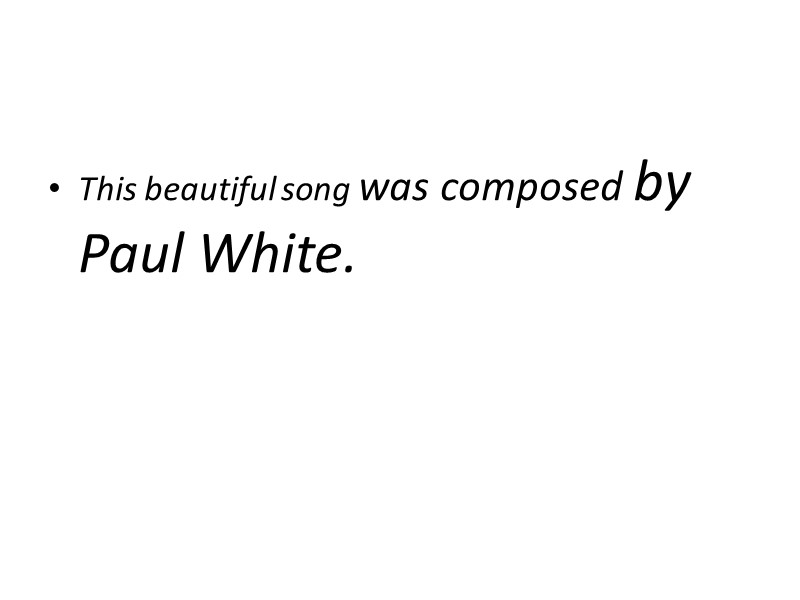

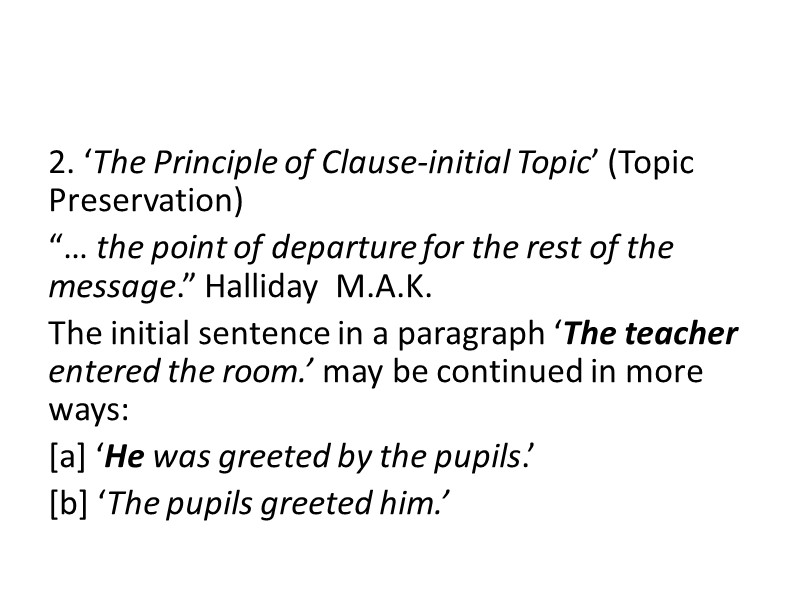
![3. ‘The Principle of End-Weight’: Example: [a] That he’s done it without help is 3. ‘The Principle of End-Weight’: Example: [a] That he’s done it without help is](https://present5.com/presentacii-2/20171213\41748-fsp_-_lecture.ppt\41748-fsp_-_lecture_11.jpg)
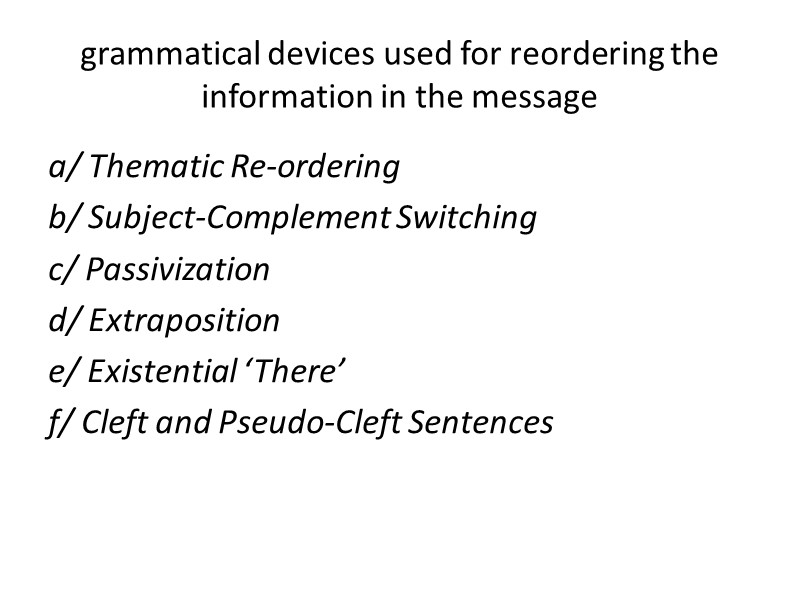
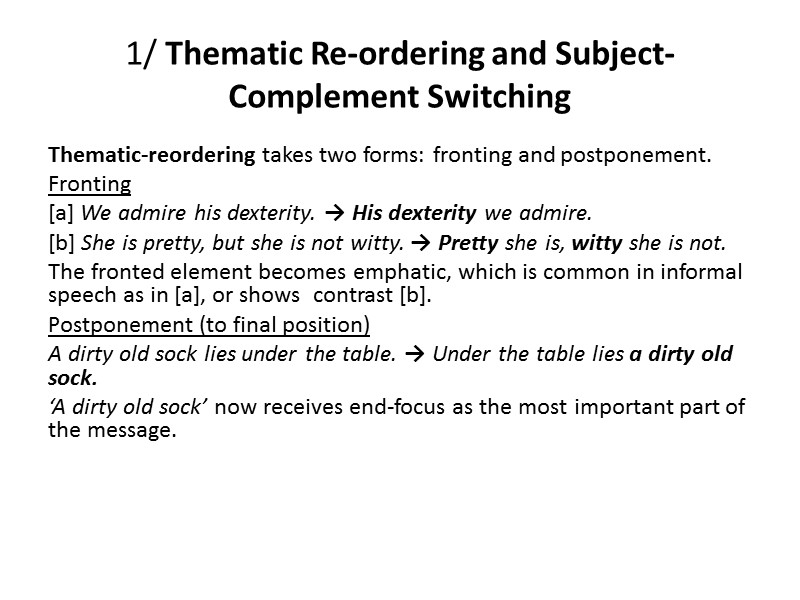
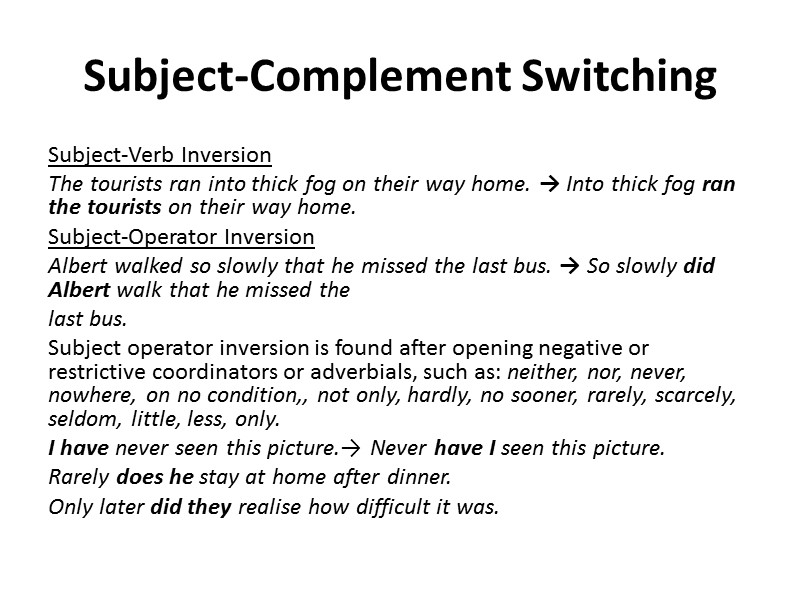
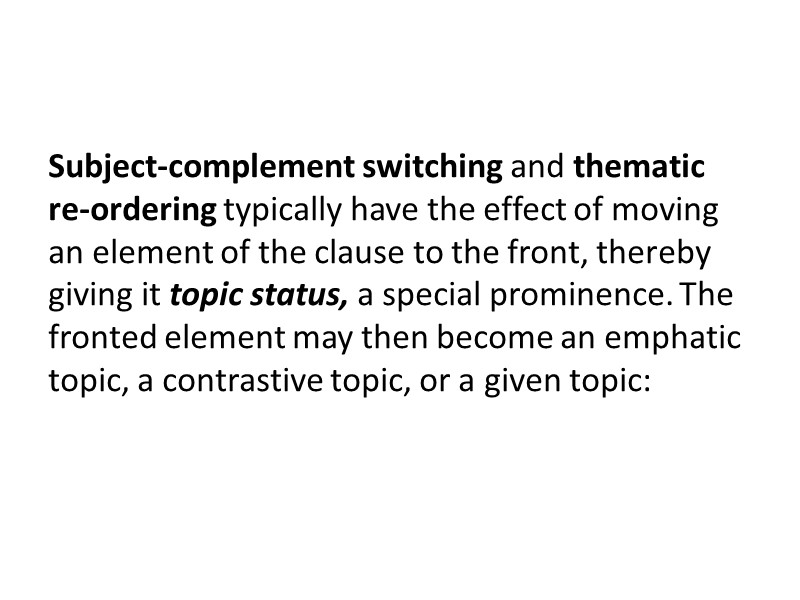
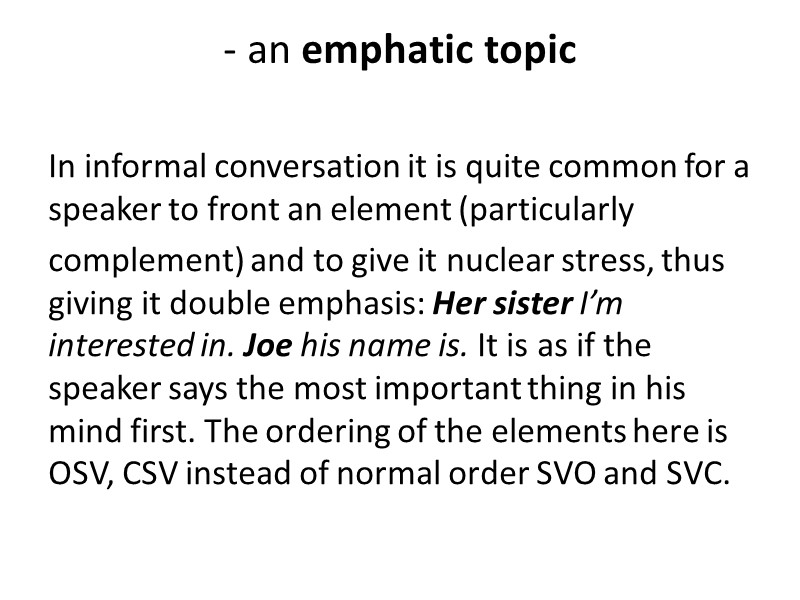
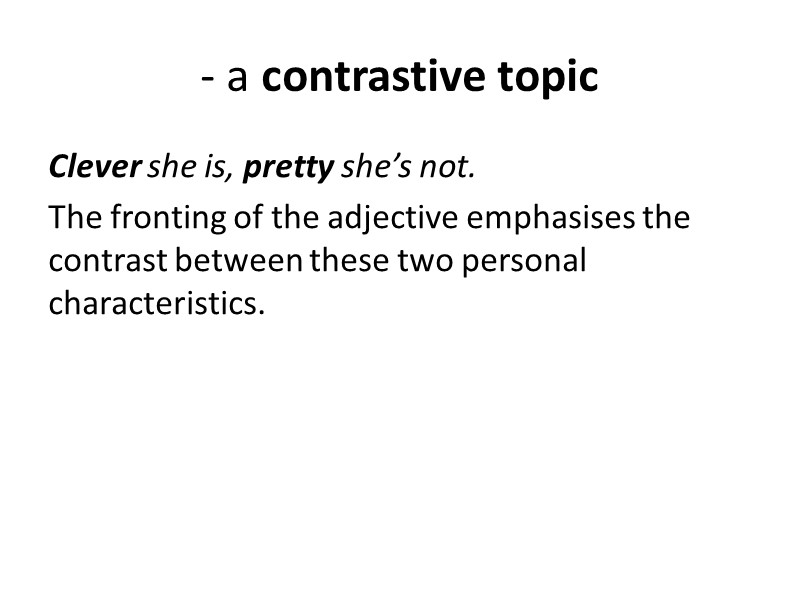
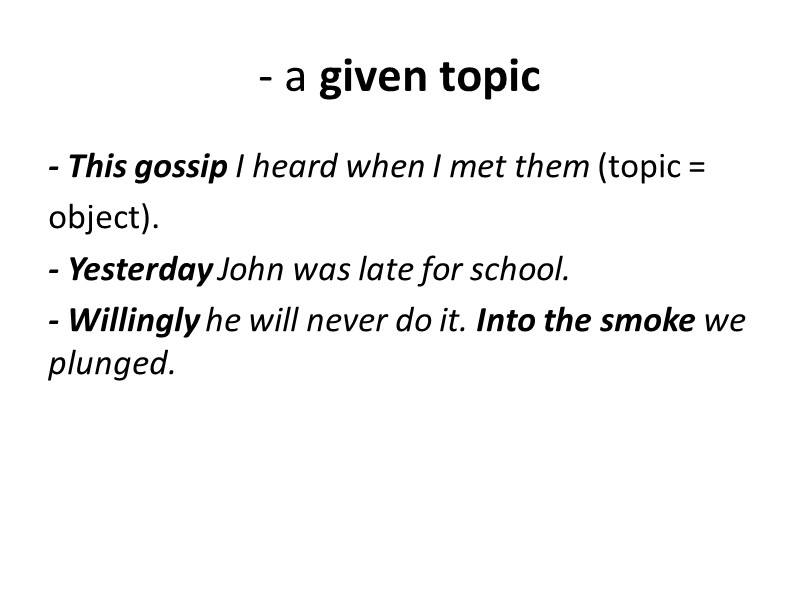
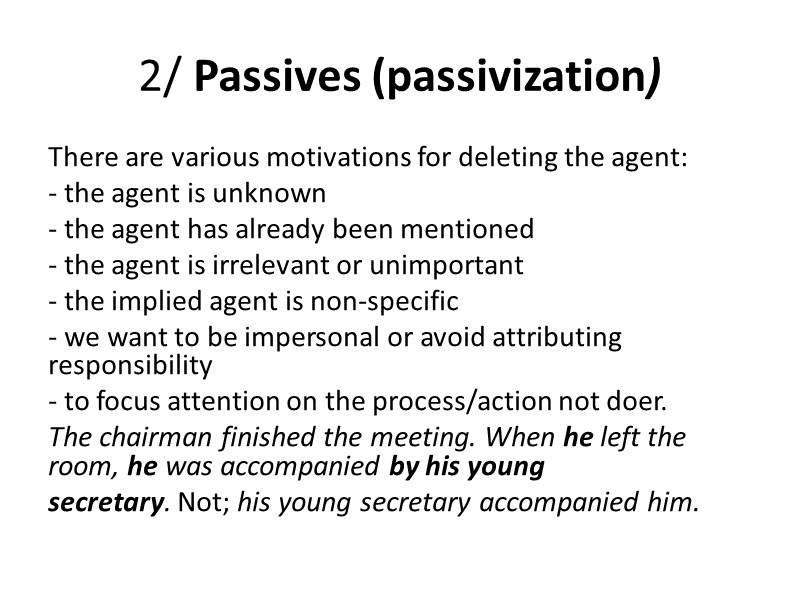
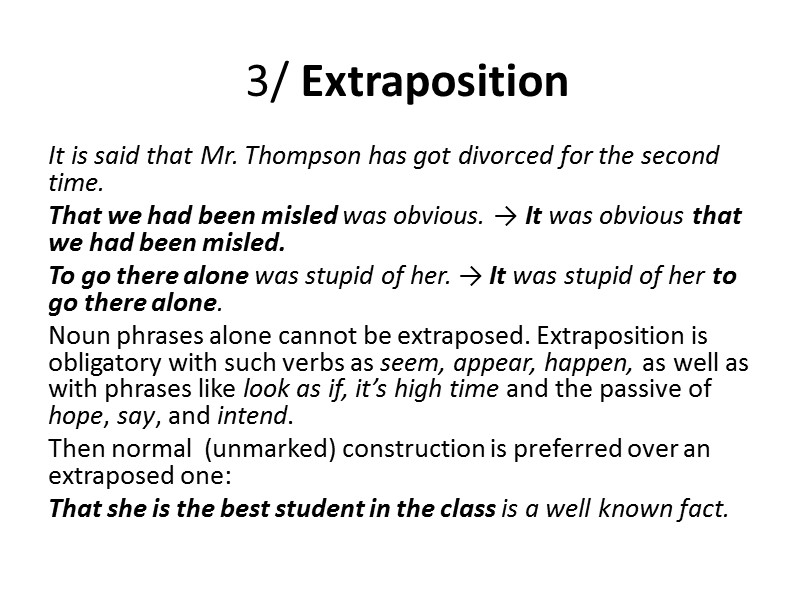
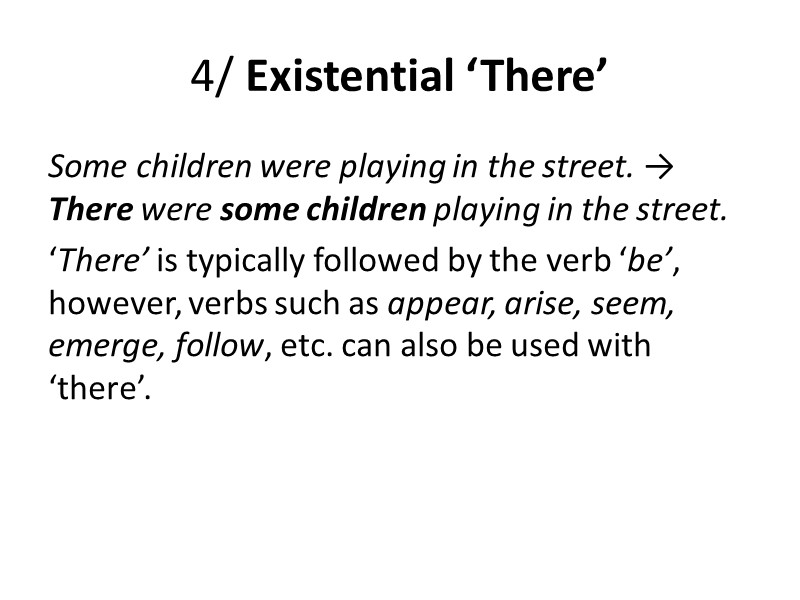
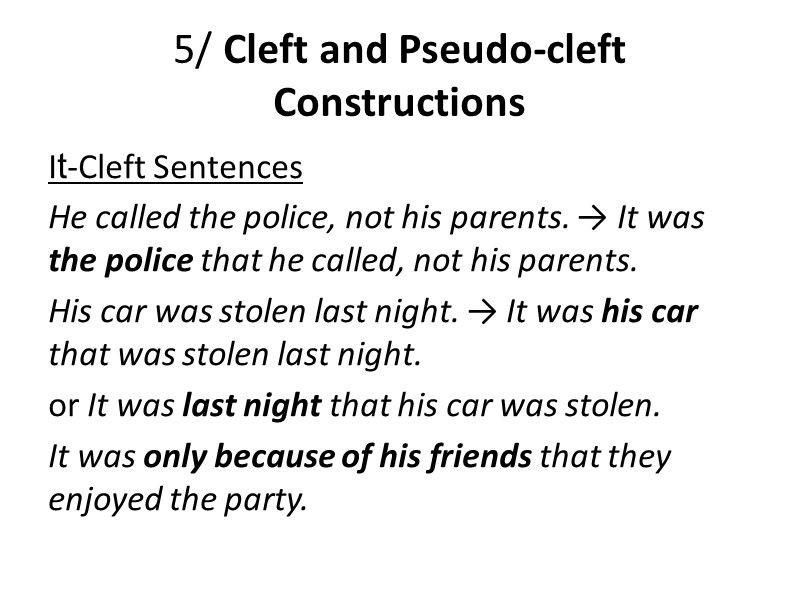
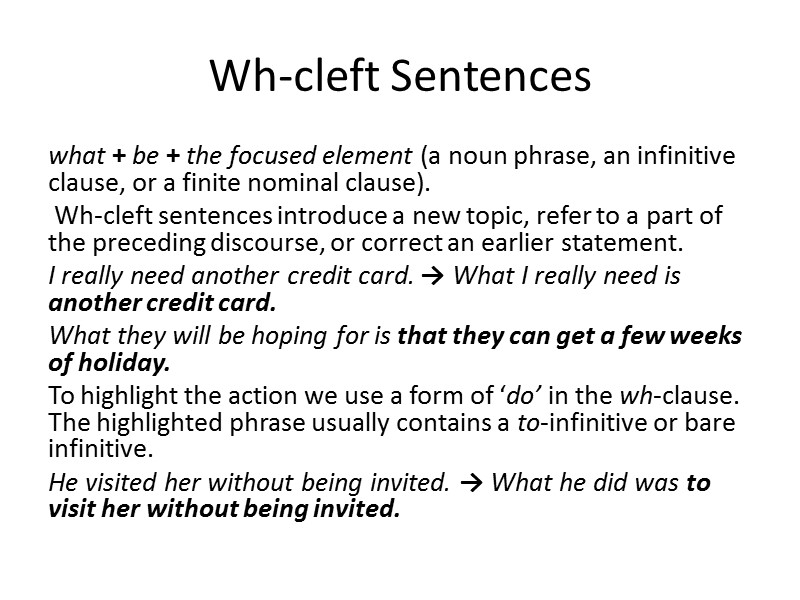
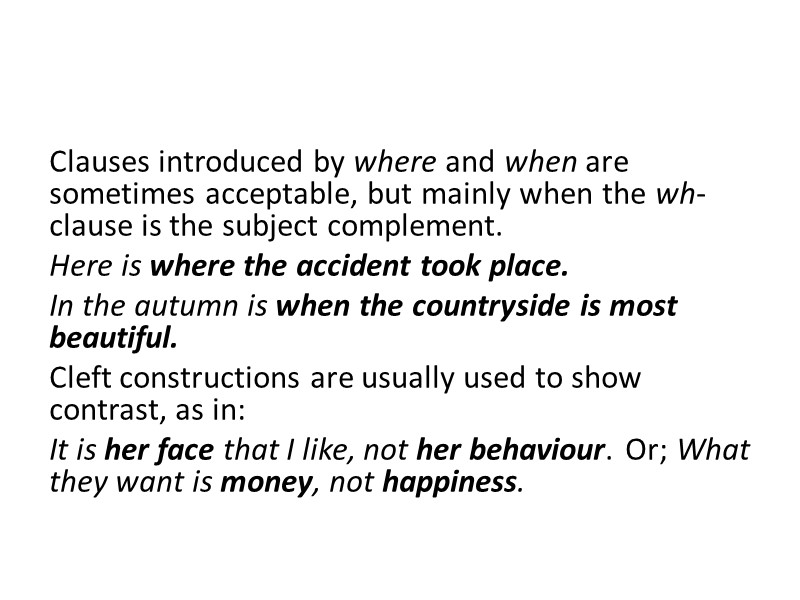
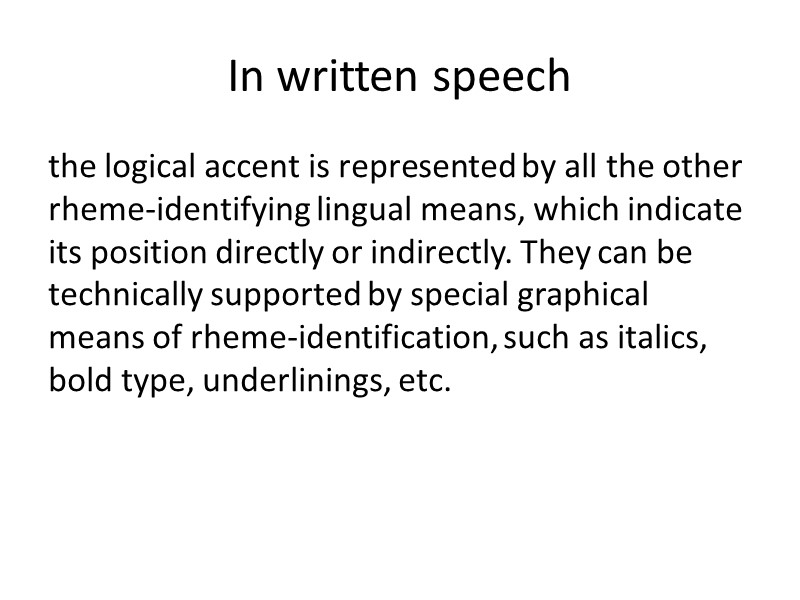
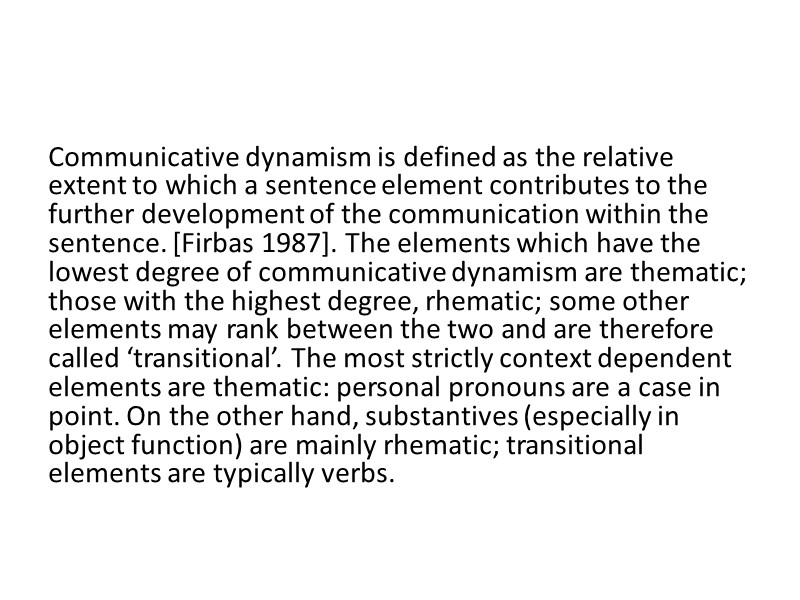
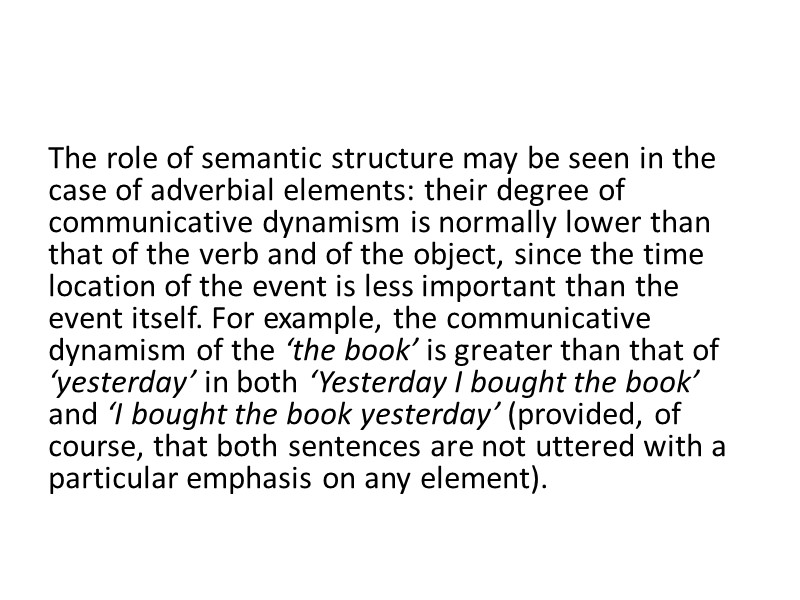
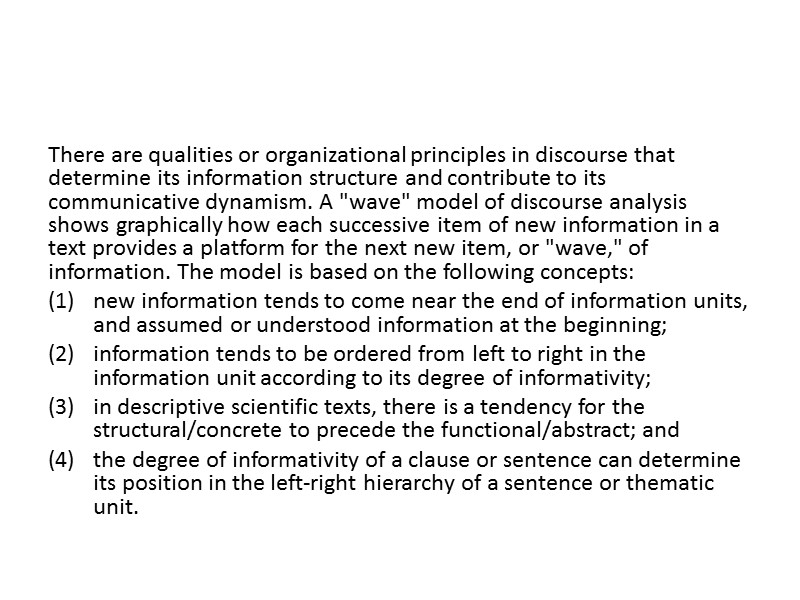
41748-fsp_-_lecture.ppt
- Количество слайдов: 28
 Functional Sentence Perspective
Functional Sentence Perspective
 There are three dominant conceptions of functional sentence perspective (FSP): (1) a sentence should be analyzed into several segments, each having a different degree of what is called communicative dynamism; (2) a sentence should be analyzed into two segments, the theme and the rheme; and (3) a sentence should be analyzed into two segments, the topic and the comment.
There are three dominant conceptions of functional sentence perspective (FSP): (1) a sentence should be analyzed into several segments, each having a different degree of what is called communicative dynamism; (2) a sentence should be analyzed into two segments, the theme and the rheme; and (3) a sentence should be analyzed into two segments, the topic and the comment.
 ACTUAL DIVISION OF THE SENTENCE the Prague Lingistic Circle 20th century Vilém Mathesius informative value of parts of the sentence informative perspective of an utterance “actual division” = the functional analysis of the sentence = the communicative analysis = the actual division analysis =the informative perspective analysis.
ACTUAL DIVISION OF THE SENTENCE the Prague Lingistic Circle 20th century Vilém Mathesius informative value of parts of the sentence informative perspective of an utterance “actual division” = the functional analysis of the sentence = the communicative analysis = the actual division analysis =the informative perspective analysis.
 the theme (“already known” information) = “the basis” the rheme (new information)= “the nucleus” “a transition” a secondary rheme, the “subrhematic” part of a sentence Again Charlie is late. – Again (transition) Charlie (theme) is late (rheme).
the theme (“already known” information) = “the basis” the rheme (new information)= “the nucleus” “a transition” a secondary rheme, the “subrhematic” part of a sentence Again Charlie is late. – Again (transition) Charlie (theme) is late (rheme).
 The principal parts of the proposition are the logical subject = the theme the logical predicate = the rheme ;
The principal parts of the proposition are the logical subject = the theme the logical predicate = the rheme ;
 “direct”, “unspecialized”, or “unmarked” = the theme precedes the rheme; Charlie is late. - Charlie (theme) is late (rheme). “inverted”, “reverse”, “specialized”, or “marked” = the rheme precedes the theme Who is late today? – Charlie (rheme) is late (theme).
“direct”, “unspecialized”, or “unmarked” = the theme precedes the rheme; Charlie is late. - Charlie (theme) is late (rheme). “inverted”, “reverse”, “specialized”, or “marked” = the rheme precedes the theme Who is late today? – Charlie (rheme) is late (theme).
 Their house will ultimately be rebuilt. → It will be some time before their house is rebuilt. Peter sent a message to Kate. → Kate received a message from Peter. The teacher punished his pupils. → What the teacher did was punish the pupils.
Their house will ultimately be rebuilt. → It will be some time before their house is rebuilt. Peter sent a message to Kate. → Kate received a message from Peter. The teacher punished his pupils. → What the teacher did was punish the pupils.
 This beautiful song was composed by Paul White.
This beautiful song was composed by Paul White.
 1. ‘The Given-New Principle’ (Principle of End Focus); ‘Who wrote this message?’ may be: [a] ‘Heather wrote it.’, or [b] ‘It was written by Heather.’
1. ‘The Given-New Principle’ (Principle of End Focus); ‘Who wrote this message?’ may be: [a] ‘Heather wrote it.’, or [b] ‘It was written by Heather.’
 2. ‘The Principle of Clause-initial Topic’ (Topic Preservation) “… the point of departure for the rest of the message.” Halliday M.A.K. The initial sentence in a paragraph ‘The teacher entered the room.’ may be continued in more ways: [a] ‘He was greeted by the pupils.’ [b] ‘The pupils greeted him.’
2. ‘The Principle of Clause-initial Topic’ (Topic Preservation) “… the point of departure for the rest of the message.” Halliday M.A.K. The initial sentence in a paragraph ‘The teacher entered the room.’ may be continued in more ways: [a] ‘He was greeted by the pupils.’ [b] ‘The pupils greeted him.’
![>3. ‘The Principle of End-Weight’: Example: [a] That he’s done it without help is >3. ‘The Principle of End-Weight’: Example: [a] That he’s done it without help is](https://present5.com/presentacii-2/20171213\41748-fsp_-_lecture.ppt\41748-fsp_-_lecture_11.jpg) 3. ‘The Principle of End-Weight’: Example: [a] That he’s done it without help is obvious. [b] It is obvious that he’s done it without help.
3. ‘The Principle of End-Weight’: Example: [a] That he’s done it without help is obvious. [b] It is obvious that he’s done it without help.
 grammatical devices used for reordering the information in the message a/ Thematic Re-ordering b/ Subject-Complement Switching c/ Passivization d/ Extraposition e/ Existential ‘There’ f/ Cleft and Pseudo-Cleft Sentences
grammatical devices used for reordering the information in the message a/ Thematic Re-ordering b/ Subject-Complement Switching c/ Passivization d/ Extraposition e/ Existential ‘There’ f/ Cleft and Pseudo-Cleft Sentences
 1/ Thematic Re-ordering and Subject-Complement Switching Thematic-reordering takes two forms: fronting and postponement. Fronting [a] We admire his dexterity. → His dexterity we admire. [b] She is pretty, but she is not witty. → Pretty she is, witty she is not. The fronted element becomes emphatic, which is common in informal speech as in [a], or shows contrast [b]. Postponement (to final position) A dirty old sock lies under the table. → Under the table lies a dirty old sock. ‘A dirty old sock’ now receives end-focus as the most important part of the message.
1/ Thematic Re-ordering and Subject-Complement Switching Thematic-reordering takes two forms: fronting and postponement. Fronting [a] We admire his dexterity. → His dexterity we admire. [b] She is pretty, but she is not witty. → Pretty she is, witty she is not. The fronted element becomes emphatic, which is common in informal speech as in [a], or shows contrast [b]. Postponement (to final position) A dirty old sock lies under the table. → Under the table lies a dirty old sock. ‘A dirty old sock’ now receives end-focus as the most important part of the message.
 Subject-Complement Switching Subject-Verb Inversion The tourists ran into thick fog on their way home. → Into thick fog ran the tourists on their way home. Subject-Operator Inversion Albert walked so slowly that he missed the last bus. → So slowly did Albert walk that he missed the last bus. Subject operator inversion is found after opening negative or restrictive coordinators or adverbials, such as: neither, nor, never, nowhere, on no condition,, not only, hardly, no sooner, rarely, scarcely, seldom, little, less, only. I have never seen this picture.→ Never have I seen this picture. Rarely does he stay at home after dinner. Only later did they realise how difficult it was.
Subject-Complement Switching Subject-Verb Inversion The tourists ran into thick fog on their way home. → Into thick fog ran the tourists on their way home. Subject-Operator Inversion Albert walked so slowly that he missed the last bus. → So slowly did Albert walk that he missed the last bus. Subject operator inversion is found after opening negative or restrictive coordinators or adverbials, such as: neither, nor, never, nowhere, on no condition,, not only, hardly, no sooner, rarely, scarcely, seldom, little, less, only. I have never seen this picture.→ Never have I seen this picture. Rarely does he stay at home after dinner. Only later did they realise how difficult it was.
 Subject-complement switching and thematic re-ordering typically have the effect of moving an element of the clause to the front, thereby giving it topic status, a special prominence. The fronted element may then become an emphatic topic, a contrastive topic, or a given topic:
Subject-complement switching and thematic re-ordering typically have the effect of moving an element of the clause to the front, thereby giving it topic status, a special prominence. The fronted element may then become an emphatic topic, a contrastive topic, or a given topic:
 - an emphatic topic In informal conversation it is quite common for a speaker to front an element (particularly complement) and to give it nuclear stress, thus giving it double emphasis: Her sister I’m interested in. Joe his name is. It is as if the speaker says the most important thing in his mind first. The ordering of the elements here is OSV, CSV instead of normal order SVO and SVC.
- an emphatic topic In informal conversation it is quite common for a speaker to front an element (particularly complement) and to give it nuclear stress, thus giving it double emphasis: Her sister I’m interested in. Joe his name is. It is as if the speaker says the most important thing in his mind first. The ordering of the elements here is OSV, CSV instead of normal order SVO and SVC.
 - a contrastive topic Clever she is, pretty she’s not. The fronting of the adjective emphasises the contrast between these two personal characteristics.
- a contrastive topic Clever she is, pretty she’s not. The fronting of the adjective emphasises the contrast between these two personal characteristics.
 - a given topic - This gossip I heard when I met them (topic = object). - Yesterday John was late for school. - Willingly he will never do it. Into the smoke we plunged.
- a given topic - This gossip I heard when I met them (topic = object). - Yesterday John was late for school. - Willingly he will never do it. Into the smoke we plunged.
 2/ Passives (passivization) There are various motivations for deleting the agent: - the agent is unknown - the agent has already been mentioned - the agent is irrelevant or unimportant - the implied agent is non-specific - we want to be impersonal or avoid attributing responsibility - to focus attention on the process/action not doer. The chairman finished the meeting. When he left the room, he was accompanied by his young secretary. Not; his young secretary accompanied him.
2/ Passives (passivization) There are various motivations for deleting the agent: - the agent is unknown - the agent has already been mentioned - the agent is irrelevant or unimportant - the implied agent is non-specific - we want to be impersonal or avoid attributing responsibility - to focus attention on the process/action not doer. The chairman finished the meeting. When he left the room, he was accompanied by his young secretary. Not; his young secretary accompanied him.
 3/ Extraposition It is said that Mr. Thompson has got divorced for the second time. That we had been misled was obvious. → It was obvious that we had been misled. To go there alone was stupid of her. → It was stupid of her to go there alone. Noun phrases alone cannot be extraposed. Extraposition is obligatory with such verbs as seem, appear, happen, as well as with phrases like look as if, it’s high time and the passive of hope, say, and intend. Then normal (unmarked) construction is preferred over an extraposed one: That she is the best student in the class is a well known fact.
3/ Extraposition It is said that Mr. Thompson has got divorced for the second time. That we had been misled was obvious. → It was obvious that we had been misled. To go there alone was stupid of her. → It was stupid of her to go there alone. Noun phrases alone cannot be extraposed. Extraposition is obligatory with such verbs as seem, appear, happen, as well as with phrases like look as if, it’s high time and the passive of hope, say, and intend. Then normal (unmarked) construction is preferred over an extraposed one: That she is the best student in the class is a well known fact.
 4/ Existential ‘There’ Some children were playing in the street. → There were some children playing in the street. ‘There’ is typically followed by the verb ‘be’, however, verbs such as appear, arise, seem, emerge, follow, etc. can also be used with ‘there’.
4/ Existential ‘There’ Some children were playing in the street. → There were some children playing in the street. ‘There’ is typically followed by the verb ‘be’, however, verbs such as appear, arise, seem, emerge, follow, etc. can also be used with ‘there’.
 5/ Cleft and Pseudo-cleft Constructions It-Cleft Sentences He called the police, not his parents. → It was the police that he called, not his parents. His car was stolen last night. → It was his car that was stolen last night. or It was last night that his car was stolen. It was only because of his friends that they enjoyed the party.
5/ Cleft and Pseudo-cleft Constructions It-Cleft Sentences He called the police, not his parents. → It was the police that he called, not his parents. His car was stolen last night. → It was his car that was stolen last night. or It was last night that his car was stolen. It was only because of his friends that they enjoyed the party.
 Wh-cleft Sentences what + be + the focused element (a noun phrase, an infinitive clause, or a finite nominal clause). Wh-cleft sentences introduce a new topic, refer to a part of the preceding discourse, or correct an earlier statement. I really need another credit card. → What I really need is another credit card. What they will be hoping for is that they can get a few weeks of holiday. To highlight the action we use a form of ‘do’ in the wh-clause. The highlighted phrase usually contains a to-infinitive or bare infinitive. He visited her without being invited. → What he did was to visit her without being invited.
Wh-cleft Sentences what + be + the focused element (a noun phrase, an infinitive clause, or a finite nominal clause). Wh-cleft sentences introduce a new topic, refer to a part of the preceding discourse, or correct an earlier statement. I really need another credit card. → What I really need is another credit card. What they will be hoping for is that they can get a few weeks of holiday. To highlight the action we use a form of ‘do’ in the wh-clause. The highlighted phrase usually contains a to-infinitive or bare infinitive. He visited her without being invited. → What he did was to visit her without being invited.
 Clauses introduced by where and when are sometimes acceptable, but mainly when the wh- clause is the subject complement. Here is where the accident took place. In the autumn is when the countryside is most beautiful. Cleft constructions are usually used to show contrast, as in: It is her face that I like, not her behaviour. Or; What they want is money, not happiness.
Clauses introduced by where and when are sometimes acceptable, but mainly when the wh- clause is the subject complement. Here is where the accident took place. In the autumn is when the countryside is most beautiful. Cleft constructions are usually used to show contrast, as in: It is her face that I like, not her behaviour. Or; What they want is money, not happiness.
 In written speech the logical accent is represented by all the other rheme-identifying lingual means, which indicate its position directly or indirectly. They can be technically supported by special graphical means of rheme-identification, such as italics, bold type, underlinings, etc.
In written speech the logical accent is represented by all the other rheme-identifying lingual means, which indicate its position directly or indirectly. They can be technically supported by special graphical means of rheme-identification, such as italics, bold type, underlinings, etc.
 Communicative dynamism is defined as the relative extent to which a sentence element contributes to the further development of the communication within the sentence. [Firbas 1987]. The elements which have the lowest degree of communicative dynamism are thematic; those with the highest degree, rhematic; some other elements may rank between the two and are therefore called ‘transitional’. The most strictly context dependent elements are thematic: personal pronouns are a case in point. On the other hand, substantives (especially in object function) are mainly rhematic; transitional elements are typically verbs.
Communicative dynamism is defined as the relative extent to which a sentence element contributes to the further development of the communication within the sentence. [Firbas 1987]. The elements which have the lowest degree of communicative dynamism are thematic; those with the highest degree, rhematic; some other elements may rank between the two and are therefore called ‘transitional’. The most strictly context dependent elements are thematic: personal pronouns are a case in point. On the other hand, substantives (especially in object function) are mainly rhematic; transitional elements are typically verbs.
 The role of semantic structure may be seen in the case of adverbial elements: their degree of communicative dynamism is normally lower than that of the verb and of the object, since the time location of the event is less important than the event itself. For example, the communicative dynamism of the ‘the book’ is greater than that of ‘yesterday’ in both ‘Yesterday I bought the book’ and ‘I bought the book yesterday’ (provided, of course, that both sentences are not uttered with a particular emphasis on any element).
The role of semantic structure may be seen in the case of adverbial elements: their degree of communicative dynamism is normally lower than that of the verb and of the object, since the time location of the event is less important than the event itself. For example, the communicative dynamism of the ‘the book’ is greater than that of ‘yesterday’ in both ‘Yesterday I bought the book’ and ‘I bought the book yesterday’ (provided, of course, that both sentences are not uttered with a particular emphasis on any element).
 There are qualities or organizational principles in discourse that determine its information structure and contribute to its communicative dynamism. A "wave" model of discourse analysis shows graphically how each successive item of new information in a text provides a platform for the next new item, or "wave," of information. The model is based on the following concepts: new information tends to come near the end of information units, and assumed or understood information at the beginning; information tends to be ordered from left to right in the information unit according to its degree of informativity; in descriptive scientific texts, there is a tendency for the structural/concrete to precede the functional/abstract; and the degree of informativity of a clause or sentence can determine its position in the left-right hierarchy of a sentence or thematic unit.
There are qualities or organizational principles in discourse that determine its information structure and contribute to its communicative dynamism. A "wave" model of discourse analysis shows graphically how each successive item of new information in a text provides a platform for the next new item, or "wave," of information. The model is based on the following concepts: new information tends to come near the end of information units, and assumed or understood information at the beginning; information tends to be ordered from left to right in the information unit according to its degree of informativity; in descriptive scientific texts, there is a tendency for the structural/concrete to precede the functional/abstract; and the degree of informativity of a clause or sentence can determine its position in the left-right hierarchy of a sentence or thematic unit.
